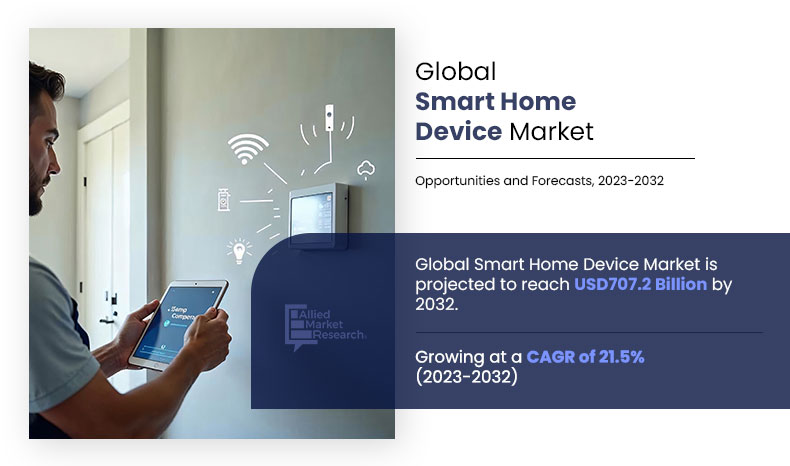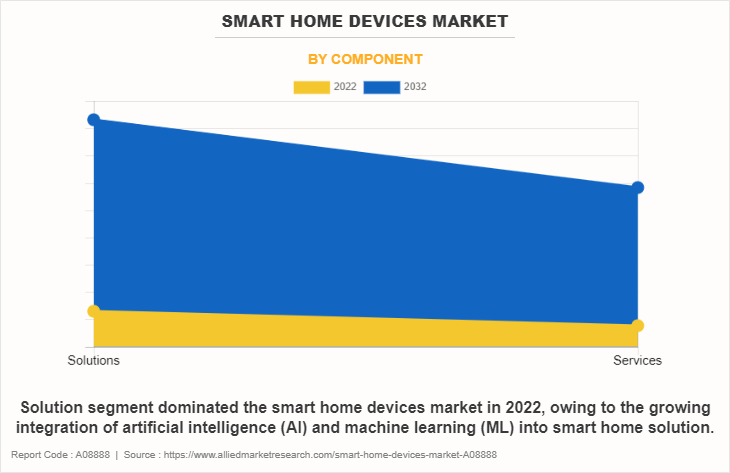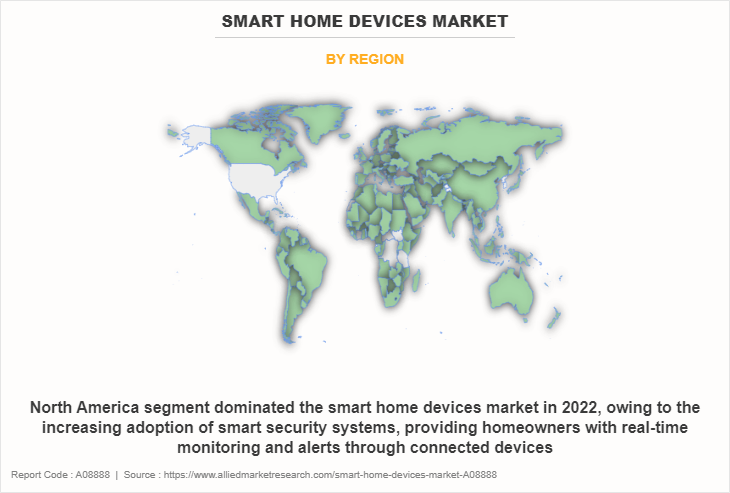Smart Home Device Market Overview
The global smart home device market size was valued at USD 101.6 billion in 2022 and is projected to reach USD 707.2 billion by 2032, growing at a CAGR of 21.5% from 2023 to 2032.
Surge rising demand for convenience, rise in awareness of energy conservation and enhancements in communication technology are primarily driving the global smart home market. However, high initial cost hamper market growth to some extent. Moreover, integration with new technologies is expected to provide lucrative opportunities for market growth during the forecast period.
Key Market Trends & Insights
- By type, the lighting control segment generated the highest revenue in 2022.
- By component, the services segment is expected to witness the highest growth during the forecast period.
- Region wise, Asia-Pacific is expected to witness the fastest CAGR during the forecast period.
Market Size & Forecast
- 2022 Market Size: USD 101.6 Billion
- 2032 Projected Market Size: USD 707.2 Billion
- Compound Annual Growth Rate (CAGR) (2023-2032): 21.5%

A smart home is a convenient configuration of appliances and other devices that are managed remotely using a mobile device or other networked device from any location with an internet connection. The internet connects all the devices in a smart home, giving the user control over things such as lighting, temperature, security access, and home theater systems remotely. Self-learning capabilities are included in smart home appliances, enabling them to recognize schedules and change, as necessary. Owners of smart homes equipped with lighting control reduce their electricity use and save money on energy-related expenses. While some home automation systems notify the homeowner if motion is detected while they are away, while other devices have the ability to contact the fire department or the police in case of an imminent situation.
Moreover, these devices use new enhanced technologies such as AI and machine learning to give people remote control and monitoring over different areas of their houses. A wide range of goods and services such as lighting control, security access control, and HVAC control devices are available in the smart home device market that form an ecosystem, which turns conventional homes into automated, intelligent, and responsive living areas.
The global smart home device market growth is significantly propelled by the surge in popularity of home automation, the rise in awareness of energy consumption, and the increase in deployment of smart technology. The smart home device market has grown owing to factors such as a rise in affordability of smart gadgets and better internet infrastructure. However, crucial issues with data security, privacy and interoperability restrain the growth of the market.
Smart Home Devices Market Segment Review:
The global smart home devices market is segmented on the basis of component, type, and region. On the basis of component, it is categorized into solution and services. On the basis of type, it is fragmented into lighting control, security access control, HVAC control, entertainment & other controls, smart kitchen, home appliances, smart furniture, and others. On the basis of region, it is analyzed across North America, Europe, Asia-Pacific, and LAMEA.
The report focuses on growth prospects, restraints, and analysis of the smart home devices trend. The study provides Porter’s five forces analysis to understand the impact of numerous factors, such as the bargaining power of suppliers, the competitive intensity of competitors, the threat of new entrants, the threat of substitutes, and the bargaining power of buyers on the smart home device market share.

On the basis of component, solution segment dominated the smart home device market in 2022 and is expected to maintain its dominance in the upcoming years owing to the growing integration of artificial intelligence (AI) and machine learning (ML) into smart home solution propels the market growth significantly. However, the services segment is expected to witness the highest growth, owing to the growing need for comprehensive service packages that come with increasingly integrated smart homes.

Region-wise, the smart home device market size was dominated by North America in 2022 and is expected to retain its position during the smart home device market forecast period, owing to the increasing adoption of smart security systems, providing homeowners with real-time monitoring and alerts through connected devices aiding the growth of the market. However, Asia-Pacific is expected to witness significant growth during the forecast period, owing to the fast-paced urban lifestyle in the region, maintaining homes needs to be convenient and efficient, which is expected to fuel the smart home device market growth in this region.
Top Impacting Factors:
Rising demand for convenience
- The increase in demand for convenience in smart home devices is deeply rooted in the modern community for efficiency, timesaving, and a more streamlined lifestyle. In this fast-paced world, individuals often find themselves juggling multiple responsibilities, and smart home devices offer a technological solution to help manage and simplify domestic tasks. The ability to remotely control home appliances, lighting, thermostats, and security systems via smartphone applications or voice commands not only provides a sense of control, however, also enables users to adapt their living spaces as per their needs with minimal effort. For example, the convenience of adjusting the thermostat on the way home, turning off lights without leaving the bed, or checking security cameras from a remote location represent the transformative impact of these devices on daily life.
- Moreover, the integration of AI and machine learning into smart home ecosystems contributes to the demand for convenience. These technologies enable devices to learn user habits and preferences, allowing automated adjustments over time. As smart home systems become more interconnected, they create synergies that amplify convenience.
- For instance, a smart thermostat works in tandem with smart blinds to optimize energy efficiency on the basis of weather conditions and occupancy patterns. This level of automation not only caters to the desire for convenience, however, also aligns with the broader trend of embracing sophisticated technologies to enhance the overall quality of life. The rise in demand for convenience in smart home devices reflects a societal shift toward embracing technology as a means to effortlessly navigate the complexities of modern living.
Enhancements in communication technology
- The enhancement of communication technologies in smart home devices is a driving force behind the transformative capabilities of these interconnected systems. With the proliferation of high-speed and reliable communication protocols, smart home devices communicate seamlessly, fostering a synchronized and responsive ecosystem. For instance, Wi-Fi enables devices to connect to the internet, facilitating remote control and monitoring through smartphone apps or cloud-based platforms. Bluetooth and Zigbee, on the other hand, allow short-range communication between devices, enabling them to form a local network within the home.
- The imminent deployment of 5G technology holds the key to even faster and more reliable communication, reducing latency and expanding the possibilities for real-time interactions. This development is particularly significant for applications that require instant responsiveness, such as security systems and smart home automation. As communication technologies continue to evolve, smart home devices offer not only enhanced convenience, however, also improved energy efficiency, security, and overall functionality, ushering in a new era of interconnected and intelligent living spaces.
Smart Home Devices Industry Regional Insights:
The smart home devices market displays notable regional differences, reflecting varying levels of adoption and growth drivers.
North America Smart Home Devices Market stands out as a leading smart home device market due to its high disposable incomes, advanced infrastructure, and a strong emphasis on energy efficiency and home automation. In the U.S. and Canada, smart devices are integrated with AI and IoT technologies, fostering growth in smart security systems, such as cameras and alarm systems.
Europe Smart Home Devices Market also represents a significant segment of the smart home device market, with strong growth in Western European countries like Germany, the UK, and France. This growth is fueled by a focus on energy efficiency and supportive government policies promoting smart home technology. The integration of smart home devices with smart city initiatives is a key trend, alongside the rising popularity of voice-activated systems. Despite this, the complexity of varying regulatory standards across countries can hinder growth of the smart home device market.
In the Asia-Pacific region Smart Home Devices Market, the market is expanding rapidly due to urbanization, increasing disposable incomes, and technological advancements. Countries like China, India, and Japan are seeing a surge in demand for smart appliances and mobile-integrated systems. However, challenges such as the variability in technological infrastructure between rural and urban areas impact smart home devices smart home device market growth.
Latin America Smart Home Devices Market is an emerging market, with significant growth potential in countries like Brazil and Mexico. The rise in disposable incomes and growing consumer awareness about smart home benefits drive adoption, particularly for affordable smart security and energy management solutions , such factors drive the smart home device market growth.
Key Smart Home Devices Companies:
The following are the leading companies in the smart home devices market. Furthermore, it highlights the strategies of the key players to improve the smart home device market share and sustain competition in the smart home devices industry.
- Johnson Controls International PLC
- Schneider Electric
- Honeywell International, Inc.
- Siemens AG
- Amazon.com
- Apple Inc.
- Google LLC
- Robert Bosch GmbH
- ADT
- Raytheon Technologies Corporation.
Recent Partnerships in the Smart Home Device Market:
In October 2022, Samsung partnered with Google to enhance smart home interoperability. Samsung and Google are building on multi-admin, allowing users to seamlessly find, choose to connect and control Matter-enabled devices through SmartThings or Google Home apps on Android.
In July 2023, Siemens partnered with PRODEA, to accelerate PRODEA investments’ digital transformation and reduce the carbon footprint of existing and under development building assets across its real estate portfolio in Greece, as well as to offer added value services to its tenants.
In December 2020, Johnson Controls partnered with Microsoft, to digitally transform how buildings and spaces are conceived, built and managed. Microsoft's Azure Digital Twins is the newest Azure platform service integrated into Johnson Controls OpenBlue platform that aims to enable the creation of next-generation IoT connected solutions that will model the real world.
Recent Product Launch in the Smart Home Device Market:
In March 2023, ADT launched ADT Self Setup smart home security system, it is the advanced and complete DIY system and the fully integrated DIY offering from ADT and Google. ADT Self Setup integrates Google's Nest smart home products with ADT security and life safety technology as well as ADT SMART Monitoring all with the convenient control of the new ADT+ app.
In January 2023, Apple launched HomePod, a powerful smart speaker that delivers next-level acoustics in a gorgeous, iconic design. Packed with Apple innovations and Siri intelligence, HomePod offers advanced computational audio for a groundbreaking listening experience, including support for immersive Spatial Audio tracks.
Key Benefits for Stakeholders:
- This report provides a quantitative analysis of the market segments, current trends, estimations, and dynamics of the smart home device market analysis from 2022 to 2032 to identify the prevailing intelligent home devices market opportunities.
- The smart home device market research is offered along with information related to key drivers, restraints, and opportunities.
- Porter's five forces analysis highlights the potency of buyers and suppliers to enable stakeholders make profit-oriented business decisions and strengthen their supplier-buyer network.
- In-depth analysis of the intelligent home devices market segmentation assists to determine the prevailing smart home devicemarket opportunities.
- Major countries in each region are mapped according to their revenue contribution to the global smart home device market.
- Market player positioning facilitates benchmarking and provides a clear understanding of the present position of the market players.
- The report includes the analysis of the regional as well as global smart home device market trends, key players, market segments, application areas, and market growth strategies.
Smart Home Devices Market Report Highlights
| Aspects | Details |
| Market Size By 2032 | USD 707.2 billion |
| Growth Rate | CAGR of 21.5% |
| Forecast period | 2022 - 2032 |
| Report Pages | 317 |
| By Component |
|
| By Type |
|
| By Region |
|
| Key Market Players | ADT, Honeywell International, Inc., Schneider Electric, Robert Bosch GmbH, Apple Inc., Siemens AG, Google LLC, Amazon, Raytheon Technologies Corporation, Johnson Controls International plc |
Analyst Review
The major players envision a smooth and networked environment in which smart gadgets converse with each other without difficulty, resulting in a more unified and harmonious smart home experience. In addition, the smart home devices market has expanded, which emphasizes the significance of user-centric innovation & technical developments and resolves privacy & interoperability issues. An emphasis on improving the overall user experience, sustainability, and collaboration is an important factor influencing the future trajectory of the market. Companies create smart home appliances that improve user experiences and merge seamlessly with user’s daily lives, requiring a thorough understanding of and commitment to addressing customer expectations. Furthermore, the expansion of the market is also significantly driven by leveraging innovative technology such as machine learning, 5G connectivity, AI deployed for building smarter and more efficient homes. Smart device data analysis yields useful insights for improving products, predicting customer preferences, and providing personalized experiences. In addition, as a growth strategy, manufacturers collaborate with other industries to enhance their devices and services. To develop comprehensive smart living solutions, manufacturers see potential synergies in collaborating with industries such as healthcare, energy, and automotive.
For instance, in March 2023, Johnson Controls launched the new IQ4 NS (No Screen) Security and Smart Home System. The new screen-free system provides the same quality and reliability customers expect from the IQ Panel 4 platform, however, at an entry-level price. The IQ4 NS allows users to take advantage of the powerful and robust feature set directly from their smart devices for added convenience and cost savings. The new IQ4 NS Security and Smart Home System features PowerG range and reliability, giving users the flexibility to create a custom-tailored solution for customers. Connectivity with Z-Wave 800 Series enables powerful smart home and automation features.?
The smart home devices market was valued at $10,1622.6 million in 2022 and is estimated to reach $70,7228.2 million by 2032
The Smart Home Devices market is projected to grow at a compound annual growth rate of 21.5% from 2023 to 2032.
Johnson Controls International PLC, Schneider Electric, Honeywell International, Inc., Siemens AG, Amazon.com, Apple Inc., Google LLC, Robert Bosch GmbH, ADT, and Raytheon Technologies Corporation are the top companies to hold the market share in Smart Home Devices.
North America is the largest regional market for Smart Home Devices
Rising demand for convenience and rise in awareness of energy conservation are the upcoming trends of Smart Home Devices Market in the world.
Loading Table Of Content...
Loading Research Methodology...



